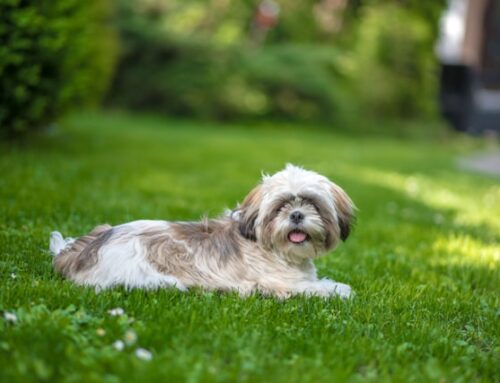Overview
Introduction: When Is It Too Cold To Walk Your Dog
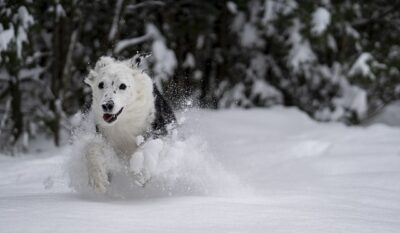
For those of us who share our lives with dogs, the daily ritual of a walk is more than just exercise; it’s a bonding experience with our furry companions. Yet, as the mercury drops, the question looms: when is it too cold to walk your dog?
Striking the delicate balance between providing ample exercise and ensuring your pet’s safety becomes paramount during the winter months. Let’s delve into the intricate world of canine cold tolerance, where factors such as extreme cold, winter weather, and colder temperatures play a crucial role.
Understanding Canine Cold Tolerance
Breed Variations
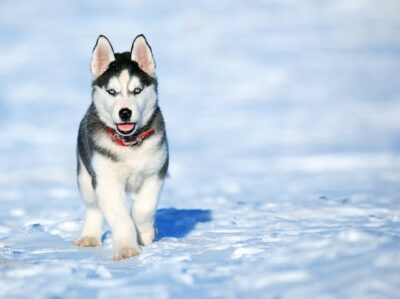
It’s fascinating how different dog breeds exhibit varying degrees of cold resistance. While breeds like the Siberian Husky may joyfully embrace the chill, our short-haired friends, with their thin coats, demand special consideration in freezing temperatures. Small dogs, in particular, often feel the bite of cold temperatures more keenly due to their lower body fat and thinner coats.
Signs of Discomfort: Deciphering Canine Body Language
In the silent language of our dogs, signs of discomfort in cold weather are communicated without a bark or whimper. Watch for subtle cues such as shivering, a clear reluctance to move, or the lifting of paws off the ground. Understanding these signals is essential, as it allows us to respond promptly and ensure our pets’ well-being during those chilly dog walks.
Temperature Guidelines
Understanding the nuances of temperature is vital when determining when it’s too cold to walk your dog. As pet parents, we want our furry friends to enjoy their outdoor excursions while also keeping an eye on their well-being in cold temperatures.
Ideal Walking Temperature Range for Different Breeds
The optimal walking temperature can vary among different dog breeds. Larger dogs with thicker fur may tolerate colder conditions better than smaller dogs with thin coats. It’s essential for pet parents to be aware of their dog’s breed and individual characteristics to determine the ideal temperature range for a comfortable and enjoyable walk.
Recognizing the Red Flags: When to Be Cautious

When the mercury drops, there are specific red flags that pet parents should heed to ensure their dog’s safety during walks.
Frostbite and Hypothermia Risks
Understanding the risks of frostbite and hypothermia is crucial, especially for small dogs or those with thin coats. In freezing temperatures, the risk of these conditions increases, potentially affecting a dog’s extremities or overall body temperature. Being aware of the signs and symptoms allows pet parents to take prompt action to prevent or address these issues.
Paw Pad Protection
One often overlooked aspect of winter walks is the potential harm to a dog’s paw pads. The harsh winter elements, including cold surfaces and ice-melting chemicals, can pose a threat to the sensitive pads on your dog’s feet. Pet parents should explore effective ways to protect their furry companion’s paw pads, ensuring a pain-free and safe winter walk.
Seasonal Considerations: When Is It Too Cold to Walk Your Dog

As the seasons change, our approach to dog walks needs to adapt to the shifting weather conditions. Ensuring your dog’s safety and well-being during different seasons involves understanding their unique vulnerabilities and adjusting your care routine accordingly.
Winter Walks vs. Cold Autumn Strolls
Is there a notable difference between taking your furry friend for a walk in the winter compared to the brisk days of autumn? The answer lies in the temperature variations and how dogs, with their varying coats and body compositions, respond to them.
In cold autumn strolls, the air carries a chill, but it’s not as biting as the winter frost. Most dogs, even those with thinner coats, can comfortably navigate the colder temperatures. However, as the winter approaches, and the temperature drops further, especially with the added challenge of wind chill, extra precautions are necessary.
Preparing Your Dog for the First Winter Outing
Introducing your dog to the colder weather for the first time requires a thoughtful approach. As temperatures plummet, shorter walks may be advisable, particularly for smaller breeds or those with thin coats. Understanding your dog’s tolerance for the cold ensures that their first winter outing is a positive experience. Consider their weight, coat thickness, and how quickly they feel the cold to make informed decisions.
As a responsible pet owner, you may also wonder, ‘when is it too cold to walk your dog?’ It’s crucial to assess the external conditions before taking your furry friend out. Factors like temperature, wind chill, and your dog’s individual tolerance to cold weather should all be taken into account. Pay attention to signs of discomfort such as shivering or a reluctance to move, and adjust their outdoor activities accordingly.
In extremely cold conditions, especially during their initial exposure to winter weather, it’s wise to err on the side of caution. Ensuring that your dog’s first experiences with colder temperatures are gradual and positive will help build their resilience. By monitoring their reactions and adjusting the duration of walks based on their comfort level, you can make the winter season enjoyable for both you and your canine companion.
Special Cases: Puppies and Senior Dogs
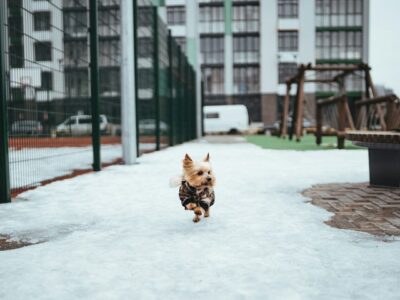
Puppies and senior dogs are special cases that demand additional attention during colder walks. These furry companions have unique vulnerabilities that necessitate specific care guidelines.
Vulnerabilities and Specific Care Guidelines
Puppies, with their developing immune systems, are more susceptible to health risks associated with colder weather. They may not regulate body temperature as efficiently as adult dogs, making it crucial to keep their walks short and protect them from brisk breezes.
Senior dogs, on the other hand, may struggle with joint issues, making it essential to provide them with extra warmth and comfort during cold walks. Their thinning coats, coupled with variations in a dog’s weight and consideration for thin dogs, may also make them more prone to feeling the cold quickly.
Watch for signs of discomfort, such as shivering or a reluctance to move, and adjust their outdoor activities accordingly. Monitoring both the age and weight, especially for thin dogs, ensures that their cold-weather experience remains safe, comfortable, and tailored to their specific needs.
Understanding that smaller breeds and those with thin coats need extra care during winter walks ensures that you keep your dog safe and comfortable. In extremely cold conditions, dogs, like humans, are at risk of developing hypothermia. Additionally, dry skin can become a concern, particularly for breeds with less protective dog’s fur.
In snowy conditions, it’s a general rule to be attentive to how your dog interacts with the snow. While some dogs may enjoy frolicking in it, others might find the cold and wetness uncomfortable. Considering other factors like wind chill and the type of snow can help you gauge your dog’s comfort level during winter walks.
If left untreated, issues related to cold weather, such as hypothermia or dry skin, can escalate. Monitoring your dog for signs of distress, adjusting the duration of walks based on their tolerance, and addressing any discomfort promptly are essential measures to ensure their well-being in winter conditions.
As a responsible pet owner, you may also wonder, ‘when is it too cold to walk your dog?’ It’s important to consider factors like temperature, wind chill, and your dog’s individual tolerance to cold weather. Be mindful of extreme conditions that can put your furry friend at risk, and prioritize their safety and well-being during winter outings.

Appropriate Dog Gear for Cold Weather
Preparing your furry friend for a winter walk involves more than just grabbing a leash. Let’s delve into the essentials of canine winter wardrobe, protective footwear, and the significance of regular vet check-ups and winter-specific vaccinations.
Canine Winter Wardrobe Essentials
Investigate the world of winter gear designed to keep your dog warm and comfortable during chilly outings, especially if your furry friend has a thin coat or varies in weight. From jackets and sweaters to protective footwear, understanding the benefits of each essential ensures your furry companion is appropriately dressed for the cold days ahead. Consider the added advantage of a water-resistant coat, providing an extra layer of protection against the elements and keeping your dog cozy in various winter conditions.
Protective Footwear
Explore the advantages of protective footwear for your dog. Not just a fashion statement, these boots can prevent injuries, especially in cold conditions where surfaces may be icy or coated with rock salt. Large dogs, in particular, benefit from the added protection to their paw pads, ensuring a safe and enjoyable dog walk.
As temperatures drop, your dog’s coat becomes a crucial factor in how they perceive and handle the cold. While thick coats provide insulation, some dogs, especially those with short hair or smaller builds, may feel the cold faster. Water-resistant coats can be especially beneficial in snowy or wet conditions, offering an extra layer of protection against heat loss.

Importance of Regular Vet Check-ups
Assessing your canine companion’s health is an ongoing responsibility, and it becomes even more crucial in cold weather. Regular vet check-ups provide insights into your dog’s overall well-being and help address any potential issues before they become more severe.
Vaccination Updates for Winter Resilience
Stay informed about winter-specific vaccinations to enhance your dog’s resilience to seasonal challenges. Rock salt used on sidewalks during colder days, for example, can pose health risks to your dog. Ensuring they are appropriately dressed for the weather and have updated vaccinations mitigates these risks and keeps them healthy throughout the winter.
Understanding your dog’s coat type and how they respond to different weather conditions is vital. For instance, in brisk breezes, large dogs may lose body heat faster, making it essential to shield them appropriately from the cold. As a general rule, the warmest part of a dog’s body is their core, emphasizing the importance of insulating their bodies during colder days.
Other factors, such as the type of snow and wind chill, also play a role in determining how cold your dog may feel during a walk. Being attuned to these factors ensures that you can make the necessary adjustments, whether it’s choosing the right attire or shortening outdoor activities on exceptionally cold days.

Indoor Exercise Alternatives
When the weather turns too cold for outdoor walks, there are plenty of indoor exercise alternatives to keep your dog active and engaged. Consider engaging in interactive play sessions with toys like puzzle feeders or indoor fetch to stimulate both physical and mental activity. Indoor obstacle courses or agility training can be a fun way to promote movement and flexibility.
These alternative exercises not only provide exercise but also strengthen the bond between you and your furry friend, ensuring they stay healthy and happy even when the weather keeps you indoors.
Interactive Toys and Games for Mental Stimulation
Interactive toys and games designed for mental stimulation are excellent options. Puzzle feeders and treat-dispensing toys challenge your dog’s problem-solving skills, keeping them mentally sharp and entertained. Consider introducing games like hide-and-seek or using interactive toys that encourage your dog to engage in independent play. These activities not only provide a mental workout but also contribute to a healthy and happy indoor exercise routine for your furry companion.
Popular Dog Breeds and Their Cold Tolerance
Arctic Breeds: Embracing the Chill
In the diverse world of dog breeds, some are natural champions when it comes to embracing the chill. Arctic breeds, renowned for their thick double coats and adaptability to cold climates, demonstrate exceptional cold tolerance. Breeds like the Siberian Husky, Alaskan Malamute, and Samoyed are not just pets; they’re cold weather enthusiasts.
Their fur, designed to insulate against freezing temperatures, keeps them warm and cozy in chilly environments. These arctic breeds thrive in colder conditions, making them excellent companions for individuals living in regions with harsh winters. Their resilience and love for the cold make them not just pets, but true winter companions ready to frolic in the snow and embrace the chill with unmatched enthusiasm.

Short-haired Breeds: Special Considerations
Short-haired dog breeds, while often admired for their sleek and low-maintenance coats, may require special considerations when it comes to cold tolerance. Breeds like the Greyhound, Dachshund, and Chihuahua have coats that offer less insulation against colder temperatures compared to their long-haired counterparts. As a result, owners of short-haired breeds need to be mindful of their pets’ exposure to chilly weather.
Investing in doggy sweaters or jackets can provide much-needed warmth during winter walks, ensuring that these pups stay comfortable and cozy. Additionally, creating a warm and sheltered environment indoors becomes crucial for short-haired breeds, offering a cozy retreat from the brisk outdoor air. With a little extra care and consideration, owners can keep their short-haired companions content and well-protected during colder seasons.
Socializing in Winter: Dog Parks and Playdates

Navigating the Challenges of Outdoor Gatherings
Dog parks in winter pose unique challenges, from icy surfaces to the brisk breeze. Learn how to navigate these challenges and create a safe and enjoyable experience for both you and your furry companion.
Indoor Alternatives for Canine Socialization
Discover indoor alternatives for socializing your dog during winter. Consider organizing playdates with fellow furry friends, exploring new toys together, or engaging in activities that promote positive interactions in the comfort of your home.
Nutrition Adjustments for Cold Weather
Ensuring Adequate Caloric Intake
As the temperature drops, understanding the importance of adjusting your dog’s diet becomes crucial. Ensure they receive sufficient calories to maintain energy levels and support their overall health during the colder months.

Explore supplements that can enhance your dog’s well-being in cold weather. From omega-3 fatty acids to vitamin D, incorporating these supplements can contribute to their overall health and resilience.
The Role of Hydration in Cold Weather
Monitoring Water Intake in Low Temperatures
In cold weather, maintaining proper hydration is crucial for overall well-being and performance. The body’s need for water does not diminish in low temperatures, and individuals may not feel as thirsty in the cold, leading to potential dehydration.
Monitoring water intake becomes imperative, as dehydration can impair cognitive function, decrease physical endurance, and compromise the body’s ability to regulate temperature. Adequate hydration also helps prevent issues like frostbite and hypothermia. Therefore, it is essential to conscientiously track and maintain proper water intake, even in chilly conditions, to ensure optimal health and performance in cold weather environments.
Signs of Dehydration During Winter Walks
In cold weather, recognizing the signs of dehydration during winter walks is paramount for maintaining health and safety. Despite the cooler temperatures, the body still loses fluids through respiration and perspiration. Common signs of dehydration in winter include increased thirst, dry or sticky mouth, dark yellow urine, and reduced urine output. Additionally, individuals may experience fatigue, dizziness, or headaches.
It’s crucial to remain vigilant and address dehydration promptly, as the cold environment can mask typical thirst cues, making it easier to overlook the body’s water needs. Staying attuned to these signs ensures that hydration is prioritized during winter activities, safeguarding well-being in colder climates.
DIY Home Remedies for Dog Paws Care
Taking care of your dog’s paws is crucial, especially during the harsh winter months. Explore homemade paw balm recipes to create effective solutions that protect your furry friend from the elements.

Paw Inspection and Care Routine
Establishing a routine for inspecting and caring for your dog’s paws is essential in ensuring they stay healthy throughout winter. Regular checks and proper care prevent issues such as cracked paw pads or discomfort during walks.
Risks of Overexertion in Cold Weather
Understanding Canine Physical Limits
In cold weather, it’s vital to recognize and respect canine physical limits to prevent the risks of overexertion. Dogs may be more susceptible to fatigue and strain in low temperatures, and pushing them beyond their limits can lead to issues such as hypothermia or muscle injuries.
Paying attention to your dog’s behavior, avoiding prolonged exposure to cold conditions, and ensuring they stay adequately warm and hydrated are essential measures to safeguard their well-being during chilly outdoor activities.
Signs of Fatigue and Strategies for Prevention
In cold weather, it’s crucial to be vigilant for signs of fatigue in your dog to prevent overexertion. Watch for cues such as excessive panting, slowed movement, or reluctance to continue activity. To mitigate these risks, incorporate frequent breaks during outdoor play, provide adequate warmth, and ensure your dog remains hydrated.
By recognizing early signs of fatigue and implementing preventive measures, you can ensure a safe and enjoyable experience for your furry companion in colder temperatures.

Training Tips for Winter Walks
Reinforcing Cold Weather Commands
For successful winter walks, reinforcing cold weather commands is essential. Ensure your dog responds reliably to commands like “heel,” “stay,” and “come” even in colder conditions. Practice these commands indoors first, gradually transitioning to outdoor settings.
Use positive reinforcement, such as treats or praise, to reward your dog for following commands in the cold. Consistent training in winter-specific situations enhances your dog’s responsiveness, making winter walks safer and more enjoyable for both of you.
Building Endurance in Chilly Conditions
To enhance your dog’s endurance for winter walks, gradually build up their tolerance to chilly conditions. Start with shorter walks and progressively increase the duration as your dog becomes accustomed to the cold. Pay attention to their comfort level, and if you notice signs of discomfort or fatigue, adjust accordingly.
Consistent, positive reinforcement during walks will help your dog associate the winter environment with positive experiences, making the training process more effective. Building endurance in chilly conditions ensures both a physically and mentally satisfying winter walk for your furry companion.
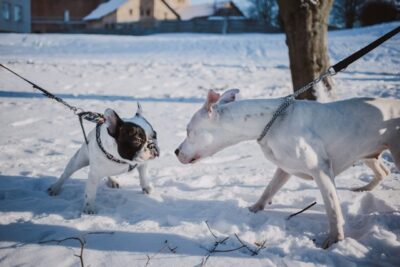
Seasonal Behavior Changes in Dogs
Understanding the Impact of Weather on Canine Behavior
Understanding the impact of weather on canine behavior is crucial, as dogs often exhibit seasonal behavior changes. In colder seasons, some dogs may become more energetic, while others might display a preference for indoor activities.
Factors like temperature, daylight duration, and weather conditions can influence a dog’s mood and activity levels. Being attuned to these seasonal behavior shifts allows pet owners to adapt their routines, ensuring their dogs remain content and well-adjusted throughout the changing weather.
Addressing Behavioral Challenges in Cold Weather
Addressing behavioral challenges in cold weather requires a thoughtful approach. Some dogs may exhibit restlessness or anxiety due to reduced outdoor activities. Providing mental stimulation through interactive indoor games, puzzle toys, or short training sessions can help channel their energy positively.
Additionally, maintaining a consistent routine, including regular walks, even in colder weather, helps dogs adapt to seasonal changes. Understanding and addressing these behavioral challenges ensures a harmonious relationship between dogs and their owners during the colder seasons.
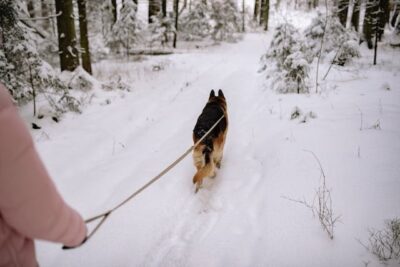
The Human Factor: Staying Safe and Warm Together
Appropriate Clothing for Dog Owners
Ensuring the safety and warmth of both dog owners and their furry companions in cold weather involves appropriate clothing choices. Dog owners should opt for insulated and waterproof attire, including jackets and boots, to stay warm during outdoor activities.
Equally important is outfitting dogs with weather-appropriate gear such as insulated coats or booties to protect their paws from cold surfaces. By dressing appropriately, both humans and their canine companions can enjoy winter outings comfortably and safely.
Teamwork: Navigating Chilly Walks Together
Navigating chilly walks together requires teamwork between dog owners and their furry friends. Dressing in layers, including warm jackets and suitable footwear, ensures human comfort, while dog owners should also equip their pets with insulated coats or booties for added warmth. Clear communication and attentiveness to each other’s needs create a positive walking experience, fostering a strong bond between the owner and their dog during cold weather outings.
Frequently Asked Questions (FAQs) – When Is It Too Cold to Walk Your Dog?
Common Concerns About Walking Dogs in Cold Weather
- Q: How do dogs feel about cold weather walks?
- A: Dogs, like humans, have varying preferences. Some breeds enjoy the chill, while others may feel cold quickly. It’s essential to observe your dog’s behavior and tailor walks to their comfort.
- Q: Is there a specific temperature at which dogs feel cold during walks?
- A: Dogs feel cold at different temperatures depending on factors like breed, coat thickness, and individual tolerance. Monitoring their behavior, especially in snowy or icy conditions, can help gauge their comfort level.
- Q: Can one dog feel the cold more than another, even within the same breed?
- A: Yes, individual dogs within the same breed may have different cold tolerances. Factors like age, health, and coat thickness contribute to variations in how each dog feels in colder temperatures.
- Q: How does snow and ice affect a dog’s paws during walks?
- A: Snow and ice can impact a dog’s paws, causing discomfort or even injuries. It’s crucial to check their paws for ice accumulation, use protective footwear if necessary, and ensure a gentle paw care routine after walks.
- Q: Are certain dog breeds more resilient to colder weather?
- A: Yes, some breeds, often those with thicker coats or originating from colder climates, are more resilient to cold weather. Understanding your dog’s breed characteristics helps in determining their cold tolerance.
- Q: Do puppies feel the cold more than adult dogs during walks?
- A: Yes, puppies, with developing immune systems and thinner coats, may feel the cold more than adult dogs. It’s essential to keep their walks short and provide extra warmth, especially in extreme cold.
- Q: How can I protect my dog’s paws during winter walks?
- A: Using protective footwear, checking for ice buildup, and applying paw balms are effective ways to protect your dog’s paws during winter walks. Establishing a paw care routine ensures their paws stay healthy.
- Q: Are there specific breeds that enjoy snowy conditions and winter walks?
- A: Yes, certain breeds, often those with double coats and a history of living in cold climates, may embrace snowy conditions. Breeds like Huskies are known for their love of chilly weather.
- Q: At what age can puppies start going on winter walks in the snow?
- A: Puppies can start going on winter walks once they have received their necessary vaccinations and their veterinarian approves outdoor activities. Introduce them gradually, considering their age, health, and breed.
- Q: Can extreme cold affect the behavior of dogs, especially pups?
- A: Yes, extreme cold can influence a dog’s behavior. Puppies, in particular, may exhibit signs of discomfort, such as shivering or reluctance to move. Adjusting their outdoor activities ensures their well-being in cold weather.
Conclusion: When Is It Too Cold To Walk Your Dog
In conclusion, understanding when is it too cold to walk your dog involves considering various factors, from breed differences to signs of discomfort and preventative measures. By prioritizing your dog’s well-being, adjusting to seasonal changes, and embracing indoor alternatives, you can ensure a happy and healthy winter for both you and your furry friend. So, gear up, stay warm, and enjoy those chilly walks together!
Remember, your dog’s comfort and safety are paramount when planning any outdoor dog walk during colder temperatures. For more insightful articles on dog care, puppies, and specific dog breeds, visit our blog, where we share valuable information for dog owners and dog lovers alike.



